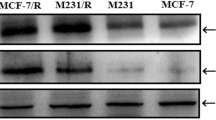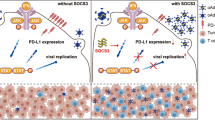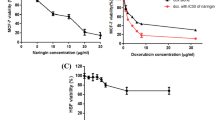Abstract
Aurora A has multiple key functions in tumor initiation and progression and is overexpressed in many cancers. Several ongoing clinical trials are assessing the unique therapeutic potential of Aurora-based targeted therapy, but several severe adverse events such as hematopoietic toxicity have been observed in the early-phase clinical trials because Aurora A is also involved in normal cells proliferation process. The strategy to develop tumor-specific inhibition of this target may be an alteration for the treatment of Aurora A overexpression tumors. In this study, we developed a novel tumor-specific RNA interference adenovirus system targeting Aurora A by using stathmin promoter and investigated the effects of it on the proliferation, apoptosis and chemotherapy sensitivity in human breast carcinoma cells both in vitro and in vivo. The results showed that treatment of human breast carcinoma cells (SK-BR-3 and MDA-MB-231) by Aurora A short hairpin RNA (shRNA) driven by stathmin gene promoter not only inhibited the cells proliferation, but also enhanced the chemosensitivity to paclitaxel via downregulation of Aurora A mRNA and protein expression, which further decreased the phosphatidylinositol 3 kinase/Akt and p-BRCA1 protein expression. Furthermore, there were no obvious phenotypes changes observed in normally differentiated epithelial cells of MCF210. Therefore, stathmin promoter-driving Aurora A shRNA adenoviral system may have potential use, with targeted tumor gene silencing effect and as adjuvant tumor-specific therapy method, in the treatment of human breast carcinomas.
This is a preview of subscription content, access via your institution
Access options
Subscribe to this journal
Receive 12 print issues and online access
$259.00 per year
only $21.58 per issue
Buy this article
- Purchase on Springer Link
- Instant access to full article PDF
Prices may be subject to local taxes which are calculated during checkout








Similar content being viewed by others
References
Beslija S, Bonneterre J, Burstein H, Cocquyt V, Gnant M, Goodwin P et al. Second consensus on medical treatment of metastatic breast cancer. Ann Oncol 2007; 18: 215–225.
Biganzoli L, Minisini A, Aapro M, Di Leo A . Chemotherapy for metastatic breast cancer. Curr Opin Obstet Gynecol 2004; 16: 37–41.
Glover DM, Leibowitz MH, McLean DA, Parry H . Mutations in aurora prevent centrosome separation leading to the formation of monopolar spindles. Cell 1995; 81: 95–105.
Andrews PD, Knatko E, Moore WJ, Swedlow JR . Mitotic mechanics: the auroras come into view. Curr Opin Cell Biol 2003; 15: 672–683.
Liu XS, Shi Y, Woods KW, Hessler P, Kroeger P, Wilsbacher J et al. Akt inhibitor A-443654 interferes with mitotic progression by regulating Aurora A kinase expression. Neoplasia 2008; 10: 828–837.
Marumoto T, Zhang D, Saya H . Aurora-A—a guardian of poles. Nat Rev Cancer 2005; 5: 42–50.
Ruchaud S, Carmena M, Earnshaw WC . Chromosomal passengers: conducting cell division. Nat Rev Mol Cell Biol 2007; 8: 798–812.
Guan Z, Wang XR, Zhu XF, Huang XF, Xu J, Wang LH et al. Aurora-A, a negative prognostic marker, increases migration and decreases radiosensitivity in cancer cells. Cancer Res 2007; 67: 10436–10444.
Cammareri P, Scopelliti A, Todaro M, Eterno V, Francescangeli F, Moyer MP et al. Aurora-A is essential for the tumorigenic capacity and chemoresistance of colorectal cancer stem cells. Cancer Res 2010; 70: 4655–4665.
Dutta-Simmons J, Zhang Y, Gorgun G, Gatt M, Mani M, Hideshima T et al. Aurora kinase A is a target of Wnt/β-catenin involved in multiple myeloma disease progression. Blood 2009; 114: 2699–2708.
Dar A, Laura W, Goff L, Majid S, Berlin J, El-Rifai W . Aurora kinases’ inhibitors—rising stars in cancer therapeutics? Mol Cancer Ther 2010; 9: 268.
Agnese V, Bazan V, Fiorentino FP, Fanale D, Badalamenti G, Colucci G et al. The role of Aurora-A inhibitors in cancer therapy. Annals Oncol 2007; 18: 47–52.
Lin F, Long M, Yan L, Gao P, Wang R, Zhang Y et al. Downregulation of stathmin expression is mediated directly by Egr1 and associated with p53 activity in lung cancer cell line A549. Cell Signal 2010; 22: 166–173.
Tong T, Zhong Y, Kong J, Dong L, Song Y, Fu M et al. Overexpression of Aurora-A contributes to malignant development of human esophageal squamous cell carcinoma. Clin Cancer Res 2004; 10: 7304–7310.
Kloog I, Stevens RG, Haim A, Portnov BA . Nighttime light level codistributes with breast cancer incidence worldwide. Cancer Causes Control 2010; 21: 2059–2068.
Pines J, Rieder CL . Re-staging mitosis: a contemporary view of mitotic progression. Nat Cell Biol 2001; 3: 3–6.
Schatten H . The mammalian centrosome and its functional significance. Histochem Cell Biol 2008; 129: 667–686.
Morris PG, Fornier MN . Microtubule active agents: beyond the taxane frontier. Clin Cancer Res 2008; 14: 7167–7172.
Zhou J, Giannakakou P . Targeting microtubules for cancer chemotherapy. Curr Med Chem Anticancer Agents 2005; 5: 65–71.
Jiang Y, Zhang Y, Lees E, Seghezzi W . AuroraA overexpression overrides the mitotic spindle checkpoint triggered by nocodazole, a microtubule destabilizer. Oncogene 2003; 22: 8293–8301.
Jantscher F, Pirker C, Mayer CE, Berger W, Sutterluety H . Overexpression of Aurora-A in primary cells interferes with S-phase entry by diminishing Cyclin D1 dependent activities. Mol Cancer 2011; 10: 28.
Shang X, Burlingame SM, Okcu MF, Ge N, Russell HV, Egler RA et al. Aurora A is a negative prognostic factor and a new therapeutic target in human neuroblastoma. Mol Cancer Ther 2009; 8: 2461–2469.
Yang H, Ou CC, Feldman RI, Nicosia SV, Kruk PA, Cheng JQ . Aurora-A kinase regulates telomerase activity through c-Myc in human ovarian and breast epithelial cells. Cancer Res 2004; 64: 463–467.
Keating AK, Kim GK, Jones AE, Donson AM, Ware K, Mulcahy JM et al. Inhibition of Mer and Axl receptor tyrosine kinases in astrocytoma cells leads to increased apoptosis and improved chemosensitivity. Mol Cancer Ther 2010; 9: 1298–1307.
Yao J, Yan M, Guan Z, Pan CB, Xia LP, Li CX et al. Aurora-A down-regulates I kappa B-á via Akt activation and interacts with insulin-like growth factor-1 induced phosphatidylinositol 3-kinase pathway for cancer cell survival. Mol Cancer 2009; 8: 95.
Yang H, He LL, Kruk P, Nicosia SV, Cheng JQ . Aurora-A induces cell survival and chemoresistance by activation of Akt through a p53-dependent manner in ovarian cancer cells. Int J Cancer 2006; 10: 2304–2312.
Boss DS, Beijnen JH, Schellens JH . Clinical experience with Aurora kinase inhibitors: a review. Oncologist 2009; 14: 780–793.
Ayuk MA, Suttiprapa S, Rinaldi G, Mann VH, Lee CM, Brindley PJ . Schistosoma mansoni U6 gene promoter-driven short hairpin RNA induces RNA interference in human fibrosarcoma cells and schistosomules. Int J Parasitol 2011; 41: 783–789.
Nie L, Das TM, Wang Y, Su Q, Zhao Y, Feng Y . Regulation of U6 promoter activity by transcriptional interference in viral vector-based RNAi. Genomics Proteomics Bioinform 2010; 8: 170–179.
Dyer V, Ely A, Bloom K, Weinberg M, Arbuthnot P . tRNA Lys3 promoter cassettes that efficiently express RNAi-activating antihepatitis B virus short hairpin RNAs. Biochem Biophys Res Commun 2010; 398: 640–646.
Abrahamyan A, Nagy E, Golovan SP . Human H1 promoter expressed short hairpin RNAs (shRNAs) suppress avian influenza virus replication in chicken CH-SAH and canine MDCK cells. Antiviral Res 2009; 84: 159–167.
Dong K, Wang R, Wang X, Shen JJ, Lin F, Gao P et al. Tumor-specific RNAi targeting eIF4E suppresses tumor growth, induces apoptosis and enhances cisplatin cytotoxicity in human breast carcinoma cells. Breast Cancer Res Treat 2009; 113: 443–456.
Wang R, Wei SH, Lin F, Wang X, Gao P, Dong K et al. Silencing Livin gene expression to inhibit proliferation and enhance chemosensitivity in tumor cells. Cancer Gene Ther 2008; 15: 402–412.
Huang XF, Luo SK, Xu J, Li J, Xu DR, Wang LH et al. Aurora kinase inhibitory VX-680 increases Bax/Bcl-2 ratio and induces apoptosis in Aurora-A-high acute myeloid leukemia. Blood 2008; 5: 2854–2865.
Ouchi M, Fujiuchi N, Sasai K, Katayama H, Minamishima YA, Ongusaha PP et al. BRCA1 phosphorylation by Aurora-A in the regulation of G2 to M transition. J Biol Chem 2004; 279: 19643–19648.
Acknowledgements
We thank everyone of the department of Medicine Laboratory and Research Center in Tangdu Hospital, Fourth Military Medicine University for their sincere help and technical supports. This study was supported by grant from National Natural Science Foundation of China (no. 30772181).
Author information
Authors and Affiliations
Corresponding author
Ethics declarations
Competing interests
The authors declare no conflict of interest.
Rights and permissions
About this article
Cite this article
Long, M., Yin, G., Liu, L. et al. Adenovirus-mediated Aurora A shRNA driven by stathmin promoter suppressed tumor growth and enhanced paclitaxel chemotherapy sensitivity in human breast carcinoma cells. Cancer Gene Ther 19, 271–281 (2012). https://doi.org/10.1038/cgt.2011.89
Received:
Revised:
Accepted:
Published:
Issue Date:
DOI: https://doi.org/10.1038/cgt.2011.89



